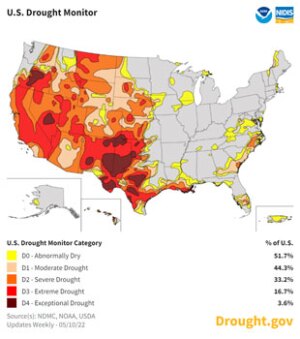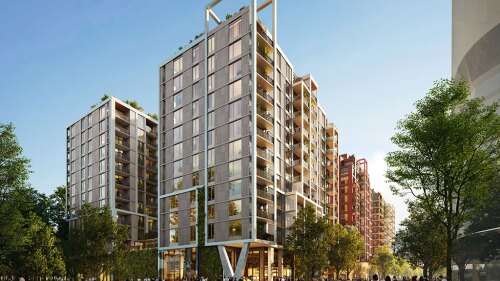
The U.S. Drought Monitor reported in 2022 that over half the United States is in drought. The U.S. Drought Monitor is jointly produced weekly by the National Drought Mitigation Center at the University of Nebraska–Lincoln, the U.S. Department of Agriculture, and the National Oceanic and Atmospheric Administration. (Map by Drought.gov)
As of 2022, the world is facing unprecedented levels of drought. Drought has extended across over half of the United States this year. The frequency, intensity, and duration of droughts are increasing, leading to myriad issues, and this pattern is expected to continue with climate change.
While available water supplies diminish through a combination of climate change, aging infrastructure, overallocation, and contamination, demands on freshwater resources are increasing.
In response, public officials at all levels are adopting increasingly rigorous water conservation measures. Historically, many of these policies focused on supply-side water management (acquiring water supplies through diversions, dams, and desalination, for example), but now most policies at the local levels are focused on demand-side water management (water conservation, efficiency, and reuse), much of which relates to the built environment.
The good news is that integrating water conservation, efficiency, and reuse into the built environment will allow for continued growth, is relatively cost-effective, and supports communities and environments. The alternative is already happening in many communities; the tap is turned off and development is halted.
Real estate and land use professionals have been and can continue to be part of the solution. In June 2022, ULI released the report Water Wise: Strategies for Drought-Resilient Development, available on Knowledge Finder. The report features best practices and case studies for incorporating water-saving measures into real estate development projects, alongside policy recommendations for integrating land use and water management.
ULI is also hosting a free webinar July 13 from 1:00 to 2:00 p.m. ET that will highlight some of the strategies for water wise development, landscaping, and policymaking. Panelists will also discuss how best to bridge the gap between the public and private sectors to advance best practices in water smart development.
Overall, the lessons learned from the best practices featured in this report and webinar are that saving water saves money and generates long-term value for assets, communities, and the environment. By working together on water conservation, efficiency, and reuse, we can protect our water future despite projected water shortages, population increases, and climate change.
A preview of key takeaways from the report:
- Market outlook: With the combination of population growth, water scarcity, and water quality issues, many communities are beginning to forecast an inability to accommodate future water needs. Some of these communities are halting real estate development, and others are requiring that developers acquire their own water supplies.
- Policy landscape: Public officials at all levels of government increasingly recognize drought as a threat to their communities and are enacting policies to address water stress. Water conservation, efficiency, and reuse are the most cost-effective and least environmentally damaging ways of meeting collective water needs.
- Public demand: Consumers are increasingly showing a preference for water-efficient fixtures, appliances, buildings, and landscapes, especially in drought-prone regions. Consumers also prefer buildings that incorporate sustainability measures, including water efficiency.
- Good business: Investing in water efficiency and conservation measures at the site scale mitigates the risk of water shortages, policy changes, and rising water prices, and garners water and energy cost savings, providing long-term value to owners and investors. Upfront investment in water and energy efficiency measures increases asset value, in some cases by 10 percent or more.
- Savings over time: The incentives to maintain water efficiency grow over time as the water and energy savings add up. To maintain or improve a property’s water efficiency over time, ongoing water management is important. Education of and communication with property owners, managers, tenants, and others is essential for reducing the water footprint of real estate through human behavior.
- Watershed protection: Compact, walkable, and transit-oriented development accommodates growth without increasing impervious surface cover and contaminated stormwater runoff, helping protect watersheds, recharge groundwater, and mitigate climate change.







